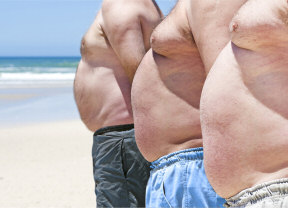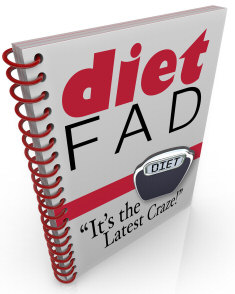The Media's Role in Obesity
 The Media’s Role in Obesity Lose the weight! Low carbs and high protein! Look
at this skinny supermodel, she lost the weight and you can too. These are some
of the lines that the media uses on a daily basis and the American public is
exposed to this constantly. There are advertisements for weight loss pills,
powders, drinks, foods, equipment, among other things. The media is everywhere
we turn these days. Most people have televisions, DVD or blu-ray players,
compact disc players, and other forms of media in their homes. Besides these
forms of media, there is also the “captive audience network” which includes
“waiting areas, elevators, restaurants, stores, buses and subways” (Maibach,
355). These areas expose us to the media without choice and can influence our
thinking. The media influences the way we eat and the body image that we have as
Americans. When waiting in the lines at the supermarket we are even exposed to
the media with all of the magazines on the shelves showing thin and attractive
celebrities. An obesity epidemic has been declared in the United States of
America and the media is partly to blame for this. We see advertisements for
different fad diets, junk foods, video games, and weight loss programs that are
not tested. The media influences the way we eat in the United States and they
contribute to the obesity epidemic through advertising fad diets and different,
untested ways to lose weight while also showing the country that thin is the way
to be; to solve this problem the media should only show proven and effective
ways to lose weight and promote more physical activities instead of sedentary
ones, while also teaching our children better ways. The Media’s Role in Obesity Lose the weight! Low carbs and high protein! Look
at this skinny supermodel, she lost the weight and you can too. These are some
of the lines that the media uses on a daily basis and the American public is
exposed to this constantly. There are advertisements for weight loss pills,
powders, drinks, foods, equipment, among other things. The media is everywhere
we turn these days. Most people have televisions, DVD or blu-ray players,
compact disc players, and other forms of media in their homes. Besides these
forms of media, there is also the “captive audience network” which includes
“waiting areas, elevators, restaurants, stores, buses and subways” (Maibach,
355). These areas expose us to the media without choice and can influence our
thinking. The media influences the way we eat and the body image that we have as
Americans. When waiting in the lines at the supermarket we are even exposed to
the media with all of the magazines on the shelves showing thin and attractive
celebrities. An obesity epidemic has been declared in the United States of
America and the media is partly to blame for this. We see advertisements for
different fad diets, junk foods, video games, and weight loss programs that are
not tested. The media influences the way we eat in the United States and they
contribute to the obesity epidemic through advertising fad diets and different,
untested ways to lose weight while also showing the country that thin is the way
to be; to solve this problem the media should only show proven and effective
ways to lose weight and promote more physical activities instead of sedentary
ones, while also teaching our children better ways.
Advertising and Fad Diets
 The media contributes to the obesity epidemic through advertising fad diets
and different, untested ways to lose weight. The Atkins diet was widely
advertised and used by many, so much so that even restaurants started making low
carbohydrate, high protein meals. Even McDonalds started selling burgers with no
buns. This diet was invented by a cardiologist named Robert Atkins because he
believed it would work based on the actions of the body when carbohydrates are
reduced and proteins are increased; however, he never did any scientific studies
to test the theory before releasing his book that caused such a craze (Dehpahlavan,
54). There are several problems with fad diets such as many of them are not
scientifically tested, they are quick weight loss programs, and individuals are
unable to keep the weight off once they stop following the diet regimen. With
these diets the quick weight loss comes from water and stored glucose being
lost, and once someone starts to eat a regular way again the weight all comes
back to them (Crowe, 1). Because these diets are not tested, their safety is not
known and they can cause many health problems. Besides the health problems they
can also cause mental issues such as depression and eating disorders. When an
individual is trying to lose weight with these fad diets and they are unable to
keep the weight off, they will often continue to try different ones without
success. This leads to depression because nothing seems to work for them and
they are unable to lose the weight they want to lose. This leads to the eating
disorders such as anorexia and bulimia because as the diets fail and the
depression sets in, these individuals turn to known ways to lose weight despite
the ill effects they cause. Anorexia is when someone does not eat or eats only a
very small amount. Many of the individuals who turn to this method end up losing
too much weight and develop digestive problems. Bulimia refers to the eating
disorder in which an individual will eat large amounts of food and then feel
guilty and induce vomiting, which also leads to depression and many digestive
issues. Neither of the eating disorders are healthy, but when the unknown fad
diets fail, they are sometimes what individuals will turn to in order to lose
weight. The media contributes to the obesity epidemic through advertising fad diets
and different, untested ways to lose weight. The Atkins diet was widely
advertised and used by many, so much so that even restaurants started making low
carbohydrate, high protein meals. Even McDonalds started selling burgers with no
buns. This diet was invented by a cardiologist named Robert Atkins because he
believed it would work based on the actions of the body when carbohydrates are
reduced and proteins are increased; however, he never did any scientific studies
to test the theory before releasing his book that caused such a craze (Dehpahlavan,
54). There are several problems with fad diets such as many of them are not
scientifically tested, they are quick weight loss programs, and individuals are
unable to keep the weight off once they stop following the diet regimen. With
these diets the quick weight loss comes from water and stored glucose being
lost, and once someone starts to eat a regular way again the weight all comes
back to them (Crowe, 1). Because these diets are not tested, their safety is not
known and they can cause many health problems. Besides the health problems they
can also cause mental issues such as depression and eating disorders. When an
individual is trying to lose weight with these fad diets and they are unable to
keep the weight off, they will often continue to try different ones without
success. This leads to depression because nothing seems to work for them and
they are unable to lose the weight they want to lose. This leads to the eating
disorders such as anorexia and bulimia because as the diets fail and the
depression sets in, these individuals turn to known ways to lose weight despite
the ill effects they cause. Anorexia is when someone does not eat or eats only a
very small amount. Many of the individuals who turn to this method end up losing
too much weight and develop digestive problems. Bulimia refers to the eating
disorder in which an individual will eat large amounts of food and then feel
guilty and induce vomiting, which also leads to depression and many digestive
issues. Neither of the eating disorders are healthy, but when the unknown fad
diets fail, they are sometimes what individuals will turn to in order to lose
weight.
Confusion as to What is Healthy
These fad diets also confuse people with what they are supposed to eat and
what is good for them. This can be seen with the new foods of the year that have
been popping up lately. Last year everyone wanted food with pomegranate in it
because it was the super food. This year it seems that the popular food is
avocado. Does this mean that pomegranate is no longer good for us? Well no, of
course not, but we do not hear about it anymore because it is not the fad this
year. With people becoming confused about what to eat it makes the American
public more likely to choose foods that they hear about through the media
advertisements and therefore are not always choosing items that have been tested
or proven to be good to eat or help with weight loss. The media also advertises
a lot of foods that are known to be bad for us, such as fast food, and lots of
Americans eat this in large quantities because we see it all the time.
Manipulating Body Image
 The media shows the United States of America that thin is the way to be. When
watching television there are many images of very slim models advertising foods,
games, products, and just about everything else. The body image has changed over
the last century and men are now portrayed as muscular, while women are shown as
thin and elegant (Lawrie, 355). The American public is subjected to these images
and it alters their body image as they feel that they need to look like these
models in order to be beautiful. This causes eating disorders and depression
that can lead to obesity and other health problems. When an individual is
subjected to seeing images of super thin models all the time and they are not
this thin it affects their self-esteem and makes them wonder why they do not
look like this. The media shows the United States of America that thin is the way to be. When
watching television there are many images of very slim models advertising foods,
games, products, and just about everything else. The body image has changed over
the last century and men are now portrayed as muscular, while women are shown as
thin and elegant (Lawrie, 355). The American public is subjected to these images
and it alters their body image as they feel that they need to look like these
models in order to be beautiful. This causes eating disorders and depression
that can lead to obesity and other health problems. When an individual is
subjected to seeing images of super thin models all the time and they are not
this thin it affects their self-esteem and makes them wonder why they do not
look like this.
Positive Messages
The media should only show proven and effective ways to lose weight. In order
for weight loss to be effective one must change their lifestyle permanently and
start a new routine. The number of calories that one burns in a day should meet
or exceed the amount of calories that they take in to lose weight and keep it
off (Dehpahlavan, 53). The media should advertise this instead of the fad diets
that do not work. Television commercials need to include exercise and weight
loss programs that are proven to work and are backed by scientific evidence.
This evidence should also be made public to help the American public to make the
best choices when looking for ways to lose weight. Obesity is taking over this
country so therefore, people need to have access to reliable forms of weight
loss.
Exercise
 Physical activity should be promoted rather than sedentary activities.
“Physical activity can be operationally defined as movement of the human body
that results in the expenditure of energy at a level above the resting metabolic
rate” (Maibach, 353). Video games are shown on television commercials along with
all the other latest gadgets that make it easier to sit around. Between 1999 and
2004 the number of children who have computers, televisions, and DVD players in
their rooms increased from 50 to 100% (Maibach, 355). This has helped to
increase sedentary activities especially for children and has decreased the
amount of physical activity. Children used to walk to school and go outside to
play every day, this does not happen anymore because of the media. It is not too
often that physical activity is shown as appealing on television; it seems that
technology and media tools have become more important since they produce a
profit whereas telling people to go outside does not. The media also shows
commercials for junk foods rather than healthy foods. If the media used its
influence to promote healthy eating and physical activity then the American
public would be more likely to get up and move while eating healthy to decrease
the rate of obesity (Leonard, 2010). Schools also need to promote more physical
activity and they could use the media to do this through commercials and
educational programs. Physical activity should be promoted rather than sedentary activities.
“Physical activity can be operationally defined as movement of the human body
that results in the expenditure of energy at a level above the resting metabolic
rate” (Maibach, 353). Video games are shown on television commercials along with
all the other latest gadgets that make it easier to sit around. Between 1999 and
2004 the number of children who have computers, televisions, and DVD players in
their rooms increased from 50 to 100% (Maibach, 355). This has helped to
increase sedentary activities especially for children and has decreased the
amount of physical activity. Children used to walk to school and go outside to
play every day, this does not happen anymore because of the media. It is not too
often that physical activity is shown as appealing on television; it seems that
technology and media tools have become more important since they produce a
profit whereas telling people to go outside does not. The media also shows
commercials for junk foods rather than healthy foods. If the media used its
influence to promote healthy eating and physical activity then the American
public would be more likely to get up and move while eating healthy to decrease
the rate of obesity (Leonard, 2010). Schools also need to promote more physical
activity and they could use the media to do this through commercials and
educational programs.
Rising Health Care Concerns
 “Childhood obesity is a worldwide pandemic that increased the risk of type II
diabetes, cardiovascular diseases, and multiple cancers and reduces the quality
of life and functional ability” (Lu, 581). There are several things that
contribute to childhood obesity such as less physical activity, fast food, young
people preparing their own food due to family dynamics, and in 2006 the
Institute of Medicine of the National Academics of Science found that “pervasive
media advertising promoting nutritionally poor food products to children” was a
significant factor also (Kunkel, 595). The way to stop obesity is to start with
the children. We must start very young and teach the children to eat healthy and
exercise. Our children must also be taught the reasons behind eating healthy and
getting exercise, otherwise they may know that they need to but not do it
because they do not know why. For example, if you tell a child not to touch a
stove they may do it anyway, but if you tell them not to touch it because it is
hot and will burn them than they will be more likely to listen. Fruit, 100%
juice, and vegetable intake go hand in hand with physical activity to combat
obesity. There have also been studies done to create behavior modifying
activities that will help to teach our children to eat healthy and be active
(Lu, 581). In order to teach our children, we must also understand. To help with
this, free or low cost programs led by nurses and doctors could be implemented
into the community to teach parents how to be healthy and prevent obesity so
that we can pass this information onto our children. Children must also be
taught in schools through health and physical education classes. It has been
said that some of the schools are cutting back or doing away with physical
education classes due to budget cuts, this must be stopped in order to save our
children and combat obesity. Our children are the future and we must teach them
if there is to be a future. “Childhood obesity is a worldwide pandemic that increased the risk of type II
diabetes, cardiovascular diseases, and multiple cancers and reduces the quality
of life and functional ability” (Lu, 581). There are several things that
contribute to childhood obesity such as less physical activity, fast food, young
people preparing their own food due to family dynamics, and in 2006 the
Institute of Medicine of the National Academics of Science found that “pervasive
media advertising promoting nutritionally poor food products to children” was a
significant factor also (Kunkel, 595). The way to stop obesity is to start with
the children. We must start very young and teach the children to eat healthy and
exercise. Our children must also be taught the reasons behind eating healthy and
getting exercise, otherwise they may know that they need to but not do it
because they do not know why. For example, if you tell a child not to touch a
stove they may do it anyway, but if you tell them not to touch it because it is
hot and will burn them than they will be more likely to listen. Fruit, 100%
juice, and vegetable intake go hand in hand with physical activity to combat
obesity. There have also been studies done to create behavior modifying
activities that will help to teach our children to eat healthy and be active
(Lu, 581). In order to teach our children, we must also understand. To help with
this, free or low cost programs led by nurses and doctors could be implemented
into the community to teach parents how to be healthy and prevent obesity so
that we can pass this information onto our children. Children must also be
taught in schools through health and physical education classes. It has been
said that some of the schools are cutting back or doing away with physical
education classes due to budget cuts, this must be stopped in order to save our
children and combat obesity. Our children are the future and we must teach them
if there is to be a future.
Conclusion
The obesity epidemic is in full swing. If we do not put an end to this soon,
it may be too late. Our children must get off the couch and away from the
media’s negative influence. The must get outside and play and get the physical
activity that is needed to prevent obesity. The media needs to change their ways
and promote healthy eating and activity. Advertising of fad diets needs to stop
now and re-education programs need to be put into place in the media. We need to
learn and teach our children how to be healthy and productive. It is impossible
to avoid the media influence, but we need to limit it as much as we can and
become active again. If we give this a try, we can do it. If we ignore it we
will be in trouble just as in the Disney movie Wall E. In this movie the humans
have left the Earth to live on a space ship. They have become so lazy that they
ride around in motorized seats all day and cannot even walk themselves. This is
where we are headed if we do not make some changes now.
References
Crowe, T. (2008). Nutrition messages given by fad diets can alter people's food
perceptions. Nutridate, 19(2), 1-4. Retrieved from EbscoHost
Dehpahlavan, J. (2004). Fad diets: A look at low-carb
trendsetting diets. plus. Today’s Chiropractic, March/April 2004, 53-56.
Retrieved from EbscoHost.
Kunkel, D. (2010). Media research contributes to the battle
against childhood obesity. Health communication, 25, 595-596.
doi:10.1080/10410236.2010.497019 Retrieved from EbscoHost
Lawrie, Z., Sullivan, E. A., Davies, R. J., & Hill, R. J.
(2006). Media influence on the body image of children and adolescents. Retrieved
from EbscoHost. Leonard, W. (2010, May). Media influence on obese children and
teenagers. Fanshawe Focus. Retrieved from EbscoHost. Eating disorders, 14,
355-364. doi: 10.1080/10640260600952506
Lu, A. S., Baranowski, J., Cullen, K. W., Jago, R., Thompson,
D., & Baranowski, T. (2010). Interactive media for childhood obesity prevention.
Health communication, 25, 581-582.
Maibach, E. (2007). The influence of the media environment on
physical activity: Looking for the big picture. American journal of health
promotion, 21, 353-362. Retrieved from EbscoHost.
Physical Fitness
Aggression in Sports
7 Simple Easy Ways to Stay Active
Exercise Tips for Busy Working Mothers
The Media's Role in Obesity
Easy Ways to Stay Toned and in Shape |